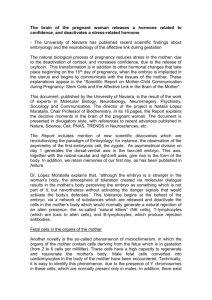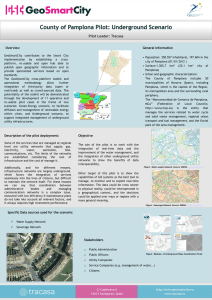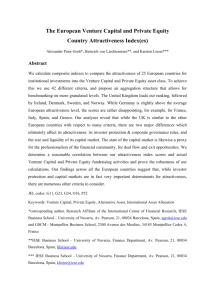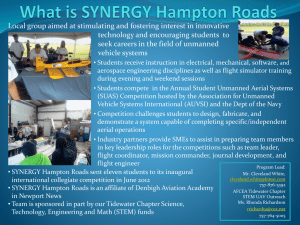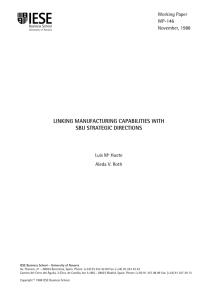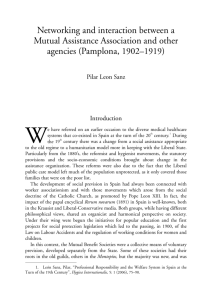Project's presentation leaflet
advertisement
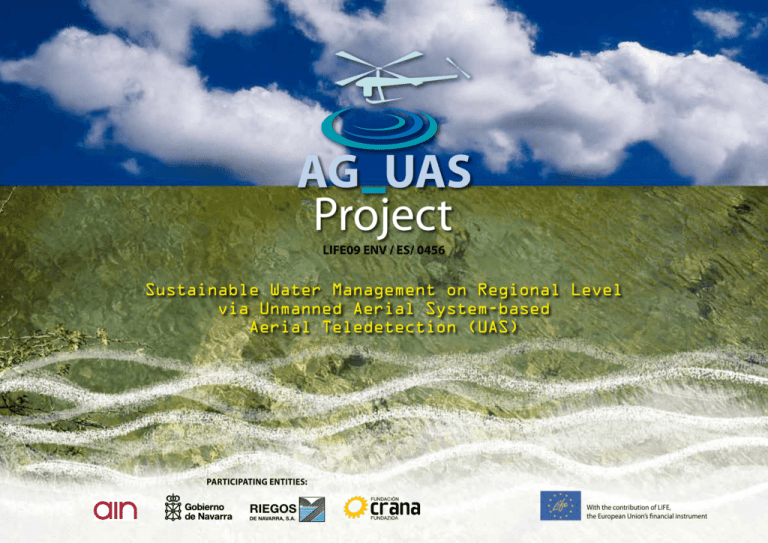
LIFE09 ENV / ES/ 0456 Sustainable Water Management on Regional Level via Unmanned Aerial System-based Aerial Teledetection (UAS) PARTICIPATING ENTITIES: RIEGOS DE NAVARRA, S.A. With the contribution of LIFE, the European Union’s financial instrument What is AG_UAS? What innovation does it bring? AG_UAS is a Life project engaged in sustainable water management on a regional level via Unmanned Aerial System-based Aerial Teledetection (UAS). The new Aerial Teledetection methodology proposed can contribute to improving present-day methods and to identifying and understanding the existing problems better. It provides full field information (image) and provides a spatial solution for a spatial problem, offering the possibility of covering large areas. Its objective is to show the technical-economic feasibility of a new Aerial Teledetection methodology, to improve global water management and contribute to its sustainable use. It is one of the Spanish projects approved by the European Union in the LIFE 2009 call, with 3-year execution time, as from 01/10/2010. The main innovation brought by AG_UAS is that it makes it possible to use teledetection from aerial means via a UAS solution, which can overcome the cost and operational capacity limitations and problems of present-day teledetection solutions (satellite and aircraft). What does it propose? To provide solutions to the problems that exist with respect to the use of water in: , Resource utilisation (efficiency of hydraulic infrastructures, irrigation optimisation, etc.) , Safety of mine exploitation storage facilities. To do this, a technology that already exists (UAS- VTOL) will be developed , Resource protection (dumping, thermal pollution, etc.) What are its specific objectives? 1 To test two new and innovative aerial teledetection systems by designing and constructing two prototypes, one based on a high resolution infrared camera and another on a multispectral camera. Both will use an unmanned helicopter as an aerial platform. 2 To demonstrate the technical feasibility of the method by executing environmental missions. 3 To demonstrate the economic feasibility of the method (assessing the operation costs of the environmental missions) 4 To promote a Dissemination Plan on a national and European level of the Project and of its results to support the EU environmental policy. 5 To develop a procedures manual to effectively apply the new methodology on sustainable water management, supporting the development and application of Directives 2000/60/EC and 2006/21/EC. , Efficient control of the water status. , Water resource inventory. that will offer us spatial information (images) What is its aim? To develop UAS-VTOL technology in order to demonstrate the technicaleconomic feasibility of the methodology in the following environmental missions: Detect leaks and filtrations in linear hydraulic transport (canals) and accumulation (dams) infrastructures. Detect dumping and emissions in surface water. 5 Detect thermal pollution in water masses. 6 Watch over the chemical and ecological status of surface water. 7 Detect the existence of ground water. 1 Aznalcollar-1998 / Spain Detect leaks and filtrations in extractive industry waste storage reservoirs. 4 2 Kolontar-2010/ Hungary Identify crop irrigation needs. Water stress in enlarged area 3 The missions will be executed within a demonstration plan that will include 142 demonstration flights, which will be carried out on surface water masses, irrigated land and infrastructures of the Foral Community of Navarra, seeking the most representative points of these infrastructures. Participating Partners? www.lifeaguas.es bThe Navarra Industry Association (AIN) is the organisation that heads Navarra Industry Association S. Cosme y S. Damián, s/n 31191 Cordovilla (Navarra) +34 948 421 101 www.ain.es lifeaguas@ain.es and coordinates the execution of this project, and is responsible for reaching the objectives set out. AIN provides services to industries in a wide range of fields such as engineering and technology, training and consultancy. It has 150 employees and 200 associated companies. bThe Department of the Environment and Rural Development is the organisation responsible for planning, coordinating, managing and executing the environmental policies of the Government of Navarra. Its competences include the protection and preservation of the environment, as well as of the water resources. Government of Navarra Department of the Environment and Rural Development c/ González Tablas, 7 31005 Pamplona (Navarra) www.navarra.es bRiegos de Navarra S.A. is a public company created by the Government of Navarra, which depends upon the Department of the Environment and Rural Development. Its aim is to control those irrigation aspects that may have a repercussion on the natural medium, especially those related to water saving, by improving the efficiency and adequate management of the irrigation systems, following the guidelines laid down by the European Framework Directive. The environmental nature of the missions, whose technical and economic feasibility is intended to be demonstrated, and the expectations created around this project, justify the participation of both entities. They will be fundamental in defining the environmental missions to be executed and in interpreting the results. bThe Environmental Resource Centre of Navarra (CRANA) is the fourth partner. It is responsible for carrying out the Project Communication and Dissemination Plan. CRANA is a foundation attached to the Directorate General for Environment of the Government of Navarra. Its commitment is to construct a new environmental culture and advance towards the sustainability of the Navarra society. RIEGOS DE NAVARRA, S.A. Riegos de Navarra S.A. Edificio de Peritos, Avda Serapio Huici nº 22 31610 Villava (Navarra) +34 948 013 055 www.riegosdenavarra.com riegosdenavarra@riegosdenavarra.com Environmental Resource Centre of Navarra C/ Padre Adoain 217 bajo 31015 Pamplona (Navarra) +34 948 140 818 www.crana.org lifeaguas@crana.org With the contribution of LIFE, the European Union’s financial instrument

